The article - advice for parents of infants about what to do so that the child learns to crawl.
Contents
- How to teach the child how to crawl correctly?
- VIDEO: Dr. Komarovsky, Crawling is useful if it's safe
- How to teach a child to crawl along? Exercises to teach a child to crawl on all fours
- How to teach a child to crawl in 4 to 5 months?
- How to teach a child to crawl in 6 - 7 months?
- VIDEO: How to teach a child to crawl?
- How to teach a child to crawl in 8 to 9 months?
- VIDEO: How to teach a child to crawl? Exercises for babies))
- Regarding the skills of kids up to a year, their small victories, the parents here split into two camps. The first think that everything has its time, and the crumb will sit down, get up, go, talk, etc., then, when it will be necessary for him. The
- The latter do not want to be outside observers and are eager to promote the development of skills in the child. Both are right in their own way
- But as for crawling, it is considered the most useful type of physical activity in infants. Psychologists and children's doctors advise moms and dads to create a crumb of all conditions so that this skill develops
How to teach the child to crawl correctly?
Usually, the child first leans four limbs and begins to crawl at the age of 6-9 months. Some babies begin to move crawling earlier, some "sloths" - later, some even completely bypass this stage of development, immediately begin to walk.
 Children who have mastered the skill of crawling have less problems with posture.
Children who have mastered the skill of crawling have less problems with posture. IMPORTANT: Crawling for a child up to a year is the best natural exercise before walking.
Parents should be aware that through games and exercises that teach this skill, they do not go to records so that the child crawls as early as possible, but stimulates crawling before walking, but at a time when the child is ready for it.
The benefits of crawling are as follows:
- Skill develops motor skills. The entire body of the baby is included in the crawl process. While engaging in this fascinating activity, he trains the muscles of the hands, legs, back, abdomen, etc. He learns to control the movements of his body, coordinate them, keep his balance. Through movement on all fours, the children strengthen the spine. Orthopedists say that in children who did not crawl, and immediately went, there are often problems with the posture of
- . Crawling has a beneficial effect on the development of the child's speech. The baby's hands are involved in the activity - it rests on the inner surfaces of the palms, where there is a huge number of nerve endings associated with the brain department responsible for speech.
- . In the process of this activity, the relationship between the right and left hemispheres of the child is established. This is a prerequisite for the subsequent formation of more complex neurological skills in him
- . Thus, the child satisfies cognitive interest and learns to be independent. Moving on all fours is the first opportunity for a baby to learn everything that is around him. After all, it was worn before by my mother or other adults. And now he can get to any corner of the room, examine and touch those objects that attract his attention.
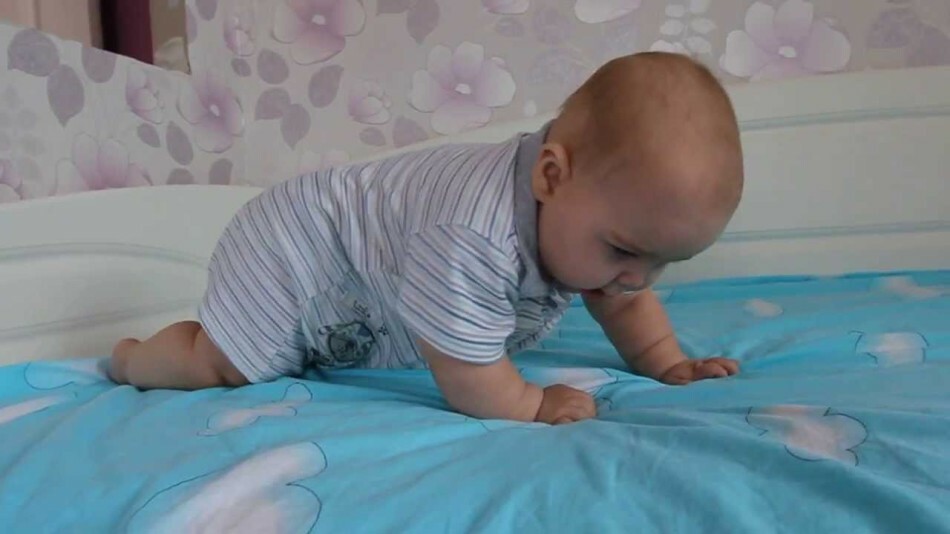 Children begin to crawl at the age of 4 to 9 months.
Children begin to crawl at the age of 4 to 9 months. Parents often wonder when and how to properly teach the child to crawl. According to experts, to create prerequisites for this type of activity in the baby is necessary from the very birth, namely:
- laying the baby on the tummy
- doing him a massage
- doing gymnastics for newborns
stimulate his cognitive interest( by his presence, toy, sound, etc.)
By the very same training on movement on all fours you can go when crumbs will be 4 months, he will learn to hold his head, turn over from the back to his tummy and make the first attempt, leaning on the handleand, to rise on bent legs.
IMPORTANT: In order for the child to crawl, it is recommended to abandon walkers, jumpers and other devices for learning to walk.
As for the style of movement on all fours, each has its own crumbs, and it is impossible to speak about one correct one. Babies often creep in this way:
- The arms of the child are straight, the legs are bent. It rests on the palms and knees. Rearranges first right hand and right foot, then left hand and left foot
- The arms of the child are straight, legs are bent. It rests on the palms and knees. Rearrange first the right arm and left leg, then the left arm and right foot
- The arms of the child are straight, the legs are bent. It rests on the palms and knees. As it throws the handles forward, or rearranges them one at a time, then moves both the
- legs simultaneously. The child's hands are straight, the legs are bent. It rests on the hands and feet. Keeping his balance with his hands, he seems to be stepping on the semi-squatting
- . The child lies on his stomach. He moves, using not only the arms and legs, but the whole body. It moves like a frog or a snake, pulling up legs or wriggling
Comfort and safety issues
To this stage in the development of a baby, like crawling, both he and his parents should be ready. They should make sure that during this activity the baby is comfortable, and he was safe.
- The child needs comfortable clothes - tight sliders.
- The floor must be clean
- The floor must not be slippery and cold
- Sharp corners need to be secured
- There should not be unnecessary and, especially, dangerous objects on the way to the baby. First of all, we are talking about electric wires. If the power sockets are located at the floor level, they must be closed with special plugs
 The child-slider, being on the floor, should be safe.
The child-slider, being on the floor, should be safe. VIDEO: Dr. Komarovsky, Crawling is useful if it's safe
How to teach a child to crawl along? Exercises to teach the child to crawl on all fours.
To teach the baby to creep forward, to rise on all fours, parents can perform with it a series of exercises.
EXERCISE # 1: Overcoming the gravity of the
In 4-5 months, the baby can begin to tear off the chest and tummy from the floor or sofa, leaning on the handles and knees. To help him do this, parents should arm themselves with an ordinary towel. He is twisted by a tubule along and put crumbs under the breast. Then, holding the two free ends, gently lift upward, so that the breast of the baby comes off the surface. At the same time the weight of his body is distributed and on his limbs, but mostly on a towel. At some point during this exercise, he will try to rearrange the arms and legs.
EXERCISE # 2: Detaching handles
This exercise is performed if the kid has already learned to stand on the handles and knees. Or they can supplement the exercise with a towel. At a distance of 15-20 cm from the person standing on all fours or "hanging" on the towel, crumbs suspend his favorite toy. The child will want to grab a toy, try to tear the handle off the ground and reach for it. This will be the first attempt to move forward on all fours.
EXERCISE # 3: Walking on the knees of the
When the kid learns to pull the knobs forward, being on three legs, you can begin to teach him how to move his knees. To do this, you need a roller - a pillow or a twisted mattress. The crumb is placed so that his chest is located on the platen, and the knees bent in the knees - on the floor. The parent becomes facing the baby in front and slowly pulls the roller toward him. The baby will have to pull up after him, moving his knees.
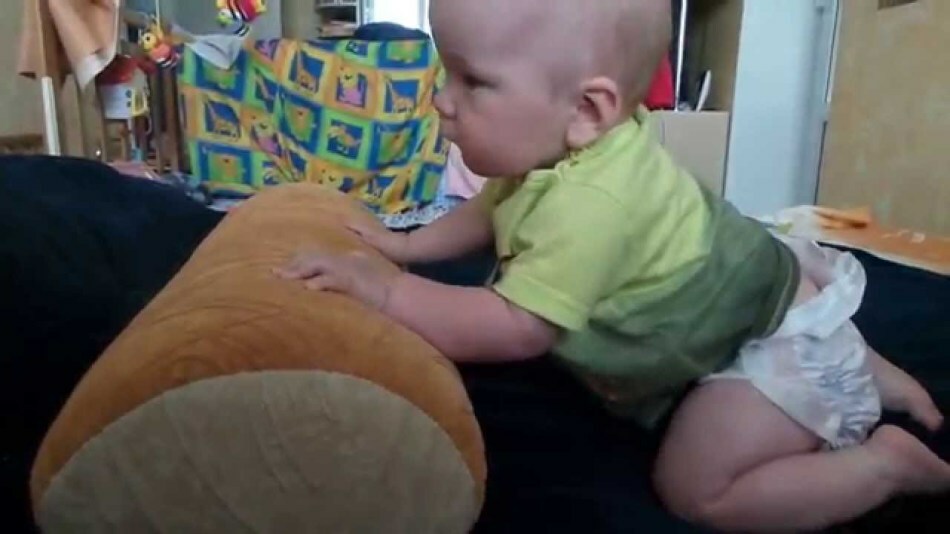 With the help of a special exercise, the baby can be helped to learn how to walk on the knees.
With the help of a special exercise, the baby can be helped to learn how to walk on the knees. EXERCISE № 4: Rushing forward
The kid confidently stands on the handles and knees, knows how to expose the handles and move the legs? It's time to urge him to crawl. To do this, you need to put it on the floor, put his favorite toy at a distance of about 30 cm from his face. Instead of a toy, there can be a mother. The kid will take some time to figure out what to get the desired object or to reach his mother he will crawl. But sooner or later he will rush forward and will be very pleased with his new skill.
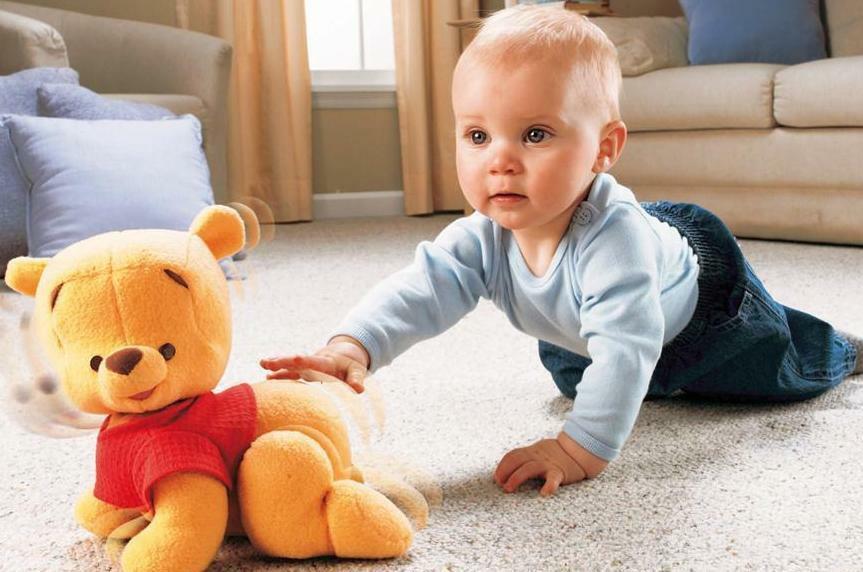 Kids often begin to crawl, trying to get their favorite toy.
Kids often begin to crawl, trying to get their favorite toy. How to teach a child to crawl in 4 to 5 months?
At this age babe can already crawl by himself. If this did not happen, the parents' task is to strengthen his locomotor apparatus, to teach him to stand on all fours.
EXERCISE # 1: Wheelbarrow
This exercise trains the arms and the shoulder girdle of crumbs. The toddler is spread on a diaper-covered table or sofa, on the tummy. The adult gently lifts his legs so that the child stands with the support of the handles. The adult stimulates the toddler to do pacing on the handles.
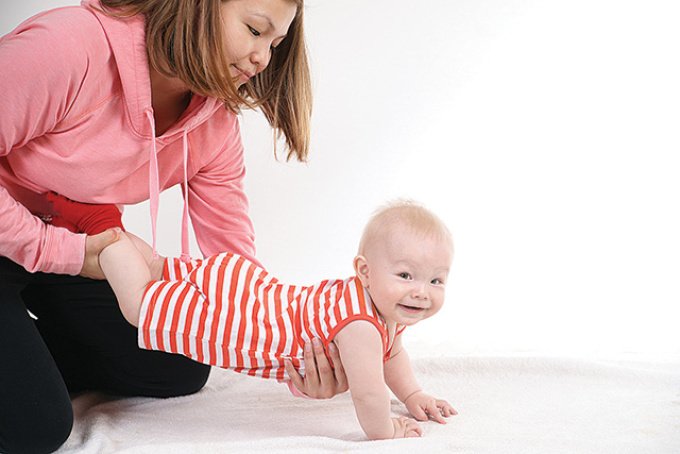 Exercise "Wheelbarrow" trains the baby's hands before crawling.
Exercise "Wheelbarrow" trains the baby's hands before crawling. EXERCISE # 2: Hovering
This exercise trains the muscles of the back, abdomen and legs. Toddler lays on the tummy, under it an adult puts his hands, connecting them with little fingers, gently raises the baby over the table. The baby reflexively unbends the spine and tries to make support on the knees.
EXERCISE № 3: Stand on all fours
The adult gets on all fours and puts the baby under him so that his back of the child and the belly of the adult touch. The adult controls the balance of the child's back and his pose on bent knees, supporting the crumb over the breast.
How to teach a child to crawl in 6 - 7 months?
In six months or a little later, children, as a rule, already make attempts to move on all fours. But sometimes they do it with reluctance or wrong. We need to help them.
EXERCISE # 1: Demonstration of
The child will want to crawl if he sees how fun others are doing. The adult himself can show the child this process on his own example. It is also good to invite a senior child who is already crawling.
 Adult on his example can show the child how to crawl.
Adult on his example can show the child how to crawl. EXERCISE # 2: Moving on all fours
If the kid stubbornly does not want to crawl on all fours, but freely moves in a plastunist manner or on straight arms and legs, he may not understand how to do it. Mom and Dad can help together. The baby needs to be put on the handles and knees. In turn, the mother must move his handles, and the father - legs. At some point, the baby will learn the mechanism of movement on all fours.
EXERCISE No. 3: Ball
This exercise will help the kid to improve his skills of movement on all fours and coordinate his own movements. The baby is given a ball, he should not howl too small. The child will get a great pleasure, chasing crawling for the ball rolling away from him.
 A ball or special toy will help the child improve the crawling skill.
A ball or special toy will help the child improve the crawling skill. VIDEO: How to teach a child to crawl?
How to teach a child to crawl in 8 - 9 months?
If a child does not crawl to 8 - 9 months, this may be a norm option, and the child, without passing this stage of development, will soon begin to stand and walk. Perhaps he has hereditary, or he is simply lazy.
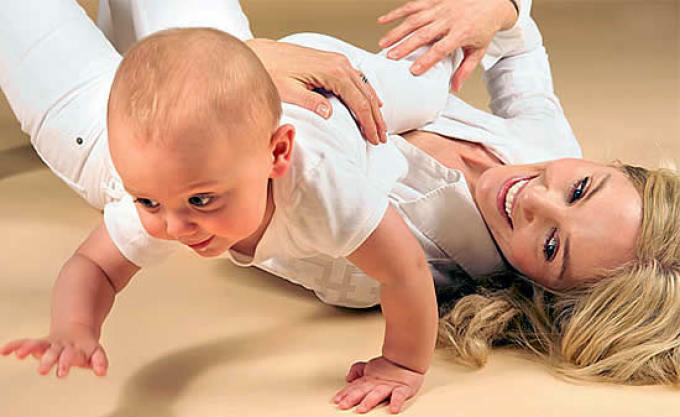 If a child is healthy and well developed, he can avoid crawling and immediately start walking at 9 to 12 months.
If a child is healthy and well developed, he can avoid crawling and immediately start walking at 9 to 12 months. But to talk to a doctor about it still worth it, because the skill can be absent from the baby for other reasons:
- Problems with muscles and ligaments. They may be underdeveloped or weak, as well as injured( fractures, sprains, bruises, etc.)
- Overweight. The musculoskeletal system of fattening infants is overexerted, which inhibits their physical development
- Neurological problems. To prevent the child from crawling can hypertonus, other
- Prolonged swaddling. A tight swaddling, especially after 3 months, inhibits the physical and mental development of the child
IMPORTANT: If the baby is healthy, develops according to age norms, but does not crawl, there should not be much excitement for the parents.
